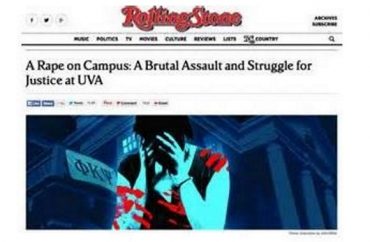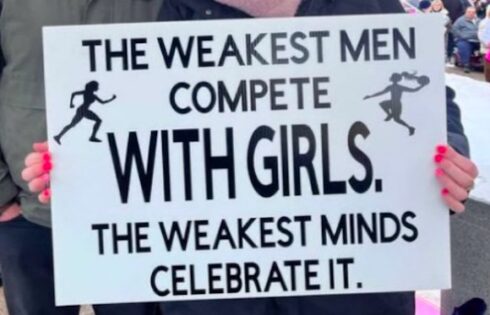
‘A story of journalistic failure that was avoidable’
Five years ago this month, Rolling Stone published what may arguably be its most famous article to date: “A Rape on Campus.”
Written by veteran journalist Sabrina Rubin Erdely, the November 2014 article detailed a purported brutal gang rape on the grounds of the University of Virginia.
The story immediately went viral and resulted in a swift suspension of all campus Greek life at UVA, touched off a national debate about the alleged campus rape epidemic, and raised the specter of a callous, dismissive university administration that cared little for victims of horrific sexual assault
It was also a hoax.
Soon after its publication it was exposed as largely fiction, tarnishing Rolling Stone‘s reputation, discrediting Erdely, spawning several lawsuits that resulted in millions of dollars in damages, and generating a comprehensive forensic journalism analysis that revealed, in the words of one Rolling Stone editor, an “institutional failure” committed by “every single person at every level” of the story’s process.
The effects of this journalistic fiasco are still felt half a decade later, and the entire saga is no less relevant today than it was in 2014.
The campus rape debate still continues — it is still a flashpoint in the United States’s ongoing cultural struggle in and about higher education. “A Rape on Campus” serves as an invaluable lesson in that dialogue, as well as a razor-sharp warning about the dangers of shoddy reporting.
‘That’s when Jackie knew she was going to be raped’
When it was published on Rolling Stone‘s website on Nov. 19, 2014, “A Rape on Campus” immediately generated an outraged nationwide response, and unsurprisingly so. Its depiction of a brutal, sadistic sex crime on an elite Virginia college campus seemed almost unfathomable, as did the university’s purportedly tepid response to its sick allegations, seeming to reveal, as one commentator at the time put it, “an institution that tolerates violence against women,” to say the very least.
The story detailed the experiences of “Jackie,” a young woman who had come to the university “intimidated by [its] aura of preppy success” yet eager to become part of the bustling campus life. Just a month into her first year there, Erdely reported, Jackie was asked on a date by “Drew,” who invited her to a “date function” at his fraternity, Phi Kappa Psi. That frat “had a reputation of tremendous wealth” as well as a prominent place on the school’s fraternity row. Jackie was “floored” to be invited.
At the fraternity house, the story said, Drew ushered her upstairs into a darkened room and shut the door, leaving them in pitch blackness. At that point, Jackie–who later said that she had not consumed any alcohol prior to the incident–was attacked, thrown through a glass coffee table, and–for “the next three hours”–gang-raped by seven men on top of broken shards of glass, all as part of a psychopathic fraternity initiation ritual. One of the rapists penetrated her with a beer bottle. At one point they subdued her by punching her in the face. Eventually she passed out, waking up alone and then stumbling through a raging frat party, “barefoot, disheveled…face beaten, dress spattered with blood.”
Erdely reported on the callow, self-interested responses of both Jackie’s friends and the school’s administration. Two friends wanted her to avoid going to the hospital for fear of all of them being excluded from future fraternity parties. A roommate later discouraged her from speaking to Erdely in case the story painted “UVA in a bad light.” Another asked her of the violent gang rape: “Why didn’t you have fun with it?”
The story also depicted Jackie’s interactions with the campus sexual assault bureaucracy, particularly with Dean Nicole Eramo, then the head of UVA’s Sexual Misconduct Board. Eramo’s depiction in the article was less-than-flattering. “If Dean Eramo was surprised at Jackie’s story of gang rape, it didn’t show,” Erdely reported. At one point Jackie allegedly asked Eramo why the university doesn’t publicize its sexual assault statistics. The story had Eramo replying: “Because nobody wants to send their daughter to the rape school.” Later, when Jackie informed Eramo about two other sexual assaults on campus, Eramo allegedly displayed a “nonreaction.”
The overall picture–a young woman subject to an unspeakable assault, a campus culture indifferent to it, a university administration unconcerned with savage sexual violence–was devastating to UVA, to its fraternities, and in a sense to American higher education in general, of which the story, by Erdely’s own admission, was meant to be representative.
University’s response
The reaction was immediate and widespread. Phi Kappa Psi initially suspended its operations on campus. Shortly thereafter, the school’s then-president, Teresa Sullivan, suspended all of the school’s Greek organizations until January. Phi Psi’s fraternity house was repeatedly vandalized in the days following the article’s publication. Sullivan asked the Charlottesville Police Department to conduct an investigation of the alleged crime. One professor at UVA wrote in Slate that the claims were “not shocking at all” because the university “has a rape culture problem.” Virginia’s then-governor Terry McAuliffe called for a “full and fair investigation” into the allegations. Senator Kristen Gillibrand cited the story in an effort to pass campus safety legislation. Several writers called for the abolition of fraternities altogether.
Sullivan, currently the interim provost at Michigan State University, was “not available for an interview” for this story, a campus spokeswoman told The College Fix. At the time of the story’s publication she served as the face of the University of Virginia, pledging to address the sickening claims presented in the article, starting with the suspension on Greek activity.
Via email, campus spokesman Brian Coy told The College Fix that “while the account featured was fictitious and ultimately debunked and retracted,” the school “took the initiative to evaluate its approach to these important issues and make changes that would improve the safety of the UVA community and the environment it offers students, faculty, staff and visitors.”
Coy outlined the extensive policy and personnel changes the school undertook following the article’s publication and eventual retraction. Those developments include well over a dozen new employees charged with adjudicating sexual assault complaints and counseling students who claim to have suffered sexual assault; mandatory Title IX training for first-year and graduate students (with mandatory refresher courses every two years); a revised Title IX policy; and numerous on-campus programs meant to combat and prevent rape.
Coy said “other factors” contributed to this overhaul, including “changes in state and federal law” and “a proactive compliance review of the University’s Title IX process by the U.S. Department of Education’s Office of Civil Rights.”
Journalists begin questioning narrative
It all had the appearance of a major shift in the campus rape debate, with UVA at the forefront of a national reckoning of evil, demented fraternity rapists. Eramo represented the weak, ineffectual campus bureaucracy. Jackie’s friends stood in for a society happy to tolerate the worst kinds of crimes imaginable. And in the center of it all was Jackie, gang-raped, her back sliced to ribbons, betrayed by her friends and abandoned by the university, her life ruined.
Yet “A Rape on Campus” did not hold up for long. It may be easy to forget, five years later, how quickly the narrative began to unravel; indeed, it was less than a week after its publication that members of the media began asking questions that the article’s writer, editors and publishers never bothered to address. Erdely had spent months and months, and countless hours, reporting and writing the story; in just over two weeks it would become known as perhaps the preeminent journalistic failure of the 21st century.
The first prominent journalist to publicly question the story was Richard Bradley, who published an essay on his website on Nov. 24, just five days after the article dropped. Bradley noted that he had in the past worked with Stephen Glass, the infamous fabulist who had made a career out of publishing stories that were in some cases complete fabrications. “The lesson I learned: One must be most critical, in the best sense of that word, about what one is already inclined to believe,” Bradley wrote.
Bradley noted several troubling features about Erdely’s article–Jackie’s anonymity, the anonymity of the rapists, the fact that Erdely never contacted them, the astonishing gang-rape story that “requires a lot of leaps of faith” to believe–and concluded by speculating that we might “never know the truth” of what happened to Jackie.
Roughly a week later, Robby Soave, an editor at Reason (as well as a former editor at The College Fix), published a similar analysis of the story, in an article provocatively titled: “Is the UVA Rape Story a Giant Hoax?” Soave pointed out numerous “perplexing details” of Erdely’s account, including “the nature of her injuries, which sound as if they would have required immediate medical attention.” He also expressed skepticism over the “almost cartoonishly evil” behavior of Jackie’s friends.
Soave, who told The College Fix this week that he had initially found the story credible, said he was surprised by the angry reactions his article generated. (At Jezebel, for instance, the writer Anna Merlan called Soave an “idiot” for his suspicions.)
“I truly did not expect the furious backlash, which was instantaneous. Nor could I have possibly anticipated just how badly Rolling Stone had screwed up here,” he said.
In his interview with The Fix, Soave explained the thinking that led to his doubting the article’s shocking claims:
My initial response to the story was the same as everyone else: This was a terrible injustice, etc. It was only after I read it a second time I started to have some doubts. The most significant factor that troubled me was Jackie’s supposed lack of intoxication…I’ve heard of premeditated rapes, and I’ve heard of gang rapes, but I don’t think I’d ever heard of a pre-planned gang rape where the victim would just be fully conscious. What if she went straight to the police? Actual predators rely on the victim’s drunken state to blur memories and cast doubt on their recollection.
In his 2014 article at Reason, Soave also cited a Washington Post interview Erdely gave around a week after the article dropped. That article, and an appearance the day before on a Slate podcast, may have been the real beginning of the article’s undoing. In those engagements, Erdely declined to say whether or not she knew the names of Jackie’s alleged rapists, as well as whether or not she approached “Drew” at any point during the reporting. She told Slate that the accused fraternity was “kind of hard to get in touch with because [the fraternity’s] contact page was pretty outdated.”
Several days after those appearances, The Post confirmed that nobody involved in the article’s writing or editing spoke to any of the accused frat brothers. “We did not talk to them. We could not reach them,” Rolling Stone editor Sean Woods told the newspaper, though he also claimed that “we verified their existence.” (Woods, via a PR firm, declined an interview request for this article.)
That revelation generated significant criticism. Erik Wemple, a media critic at The Post, called the lack of contact between the reporter and the accused rapists “inexcusable.” Wemple argued that brutal and criminal accusations leveled at the alleged perpetrators demanded a much higher degree of journalistic diligence:
If they were being cited in the story for mere drunkenness, boorish frat-boy behavior or similar collegiate misdemeanors, then there’d be no harm in failing to secure their input. The charge in this piece, however, is gang rape, and so requires every possible step to reach out and interview them, including e-mails, phone calls, certified letters, FedEx letters, UPS letters and, if all of that fails, a knock on the door. No effort short of all that qualifies as journalism.
The Post eventually sent a reporter, T. Rees Shapiro, to Charlottesville to investigate the increasingly bizarre story. Shapiro’s report, published on Dec. 5, was a devastating blow to the article’s credibility. In it, readers learned numerous key details that sharply challenged Erdely’s and Jackie’s version of events: The fraternity said no event had been held the night of the alleged attack, several of Jackie’s friends said they doubted the veracity of her account, Jackie’s story had changed considerably over multiple tellings. Jackie herself, according to the paper, admitted that “some details in the [Rolling Stone] article might not be accurate.” One of Jackie’s friends told The Post the depiction of him and his friends in the story, debating “the social price of reporting Jackie’s rape,” was false.
Damage control
Rolling Stone apparently got wind of The Post‘s investigations ahead of the paper’s publishing them, and right around the same time Shapiro’s story was posted, the magazine published what it called “A Note to Our Readers.” In it, the magazine’s managing editor, Will Dana, offered a startling sort of mea culpa regarding the now-crumbling controversial article:
In the face of new information, there now appear to be discrepancies in Jackie’s account, and we have come to the conclusion that our trust in her was misplaced. We were trying to be sensitive to the unfair shame and humiliation many women feel after a sexual assault and now regret the decision to not contact the alleged assaulters to get their account.
Dana later tweeted that he “[couldn’t] explain the discrepancies between Jackie’s account and the counter statements made by Phi Psi.” He would clarify that the magazine’s failure to do journalistic diligence “is on us—not on [Jackie].” The magazine eventually revised its initial apology to reflect Dana’s tweeted clarifications. (Dana himself declined an interview for this story, writing: “I don’t really have anything to say about it that I haven’t said before.”)
National media descended upon Charlottesville, quickly peeling back the layers of misinformation Rolling Stone had published. ABC News spoke to the three friends depicted in Erdely’s article. All three denied key aspects of Jackie’s and Erdely’s accounts, including Jackie’s claim that she had become depressed after the alleged assault. The Post discovered that no student from the school matched the description of Jackie’s principal attacker.
Perhaps most damning, the paper reported, “photographs that were texted to one of the friends showing [Jackie’s] date that night were actually pictures depicting one of Jackie’s high school classmates in Northern Virginia.” Eventually it became clear that Jackie may have completely manufactured her date’s identity, possibly in a bid to win another student’s affections.
Erdely could have easily discovered many or all of these details had she simply asked a few people a few more questions. She had access to the campus–everyone does–and she had enough details and information about Jackie, her friends and her social network that she could have triangulated certain sources and certain facts with very little effort. Incredibly, after the story began to crumble, Erdely attempted to “re-report” the article, reaching out to sources and apologizing to at least one of them.
What Erdely was thinking was anyone’s guess. A cataclysm of this magnitude requires not a “re-report” but a retraction. That was eventually what Rolling Stone would do the following April.
Yet the story had already done a considerable amount of damage, and the magazine and Erdely both would soon be facing a barrage of legal suits, as well as a humiliating and highly public analysis of how they got this story as catastrophically wrong as they did.
Lawsuits
In May 2015, six months after the article’s publication and one month after the magazine officially retracted it, Nicole Eramo filed a defamation lawsuit against Rolling Stone and Erdely. Seeking more than $7.5 million in damages, Eramo, who did not respond to email queries last week, claimed that the magazine and the writer had both made “highly defamatory and false statements” about her, categorizing Erdely as a “wanton journalist who was more concerned with writing an article that fulfilled her preconceived narrative about the victimization of women on American college campuses” and Rolling Stone as a “malicious publisher who was more concerned about selling magazines to boost the economic bottom line for its faltering magazine, than they were about discovering the truth or actual facts.”
The court battle, which would eventually grow to include a subpoenaed deposition from Jackie herself, would run until November 2016, nearly two years to the day after Erdely had characterized Eramo in print as a cold administrator indifferent to the misery of sexually assaulted college women. Eramo was awarded $3 million.
Phi Kappa Psi would also lodge its own lawsuit, filing it nearly a year after the article was published. The fraternity asked for $25 million in damages; a year later they would be awarded a small fraction of that amount, $1.65 million. In 2017 the magazine resolved a final lawsuit brought by three fraternity brothers who claimed the article implicated them in the gang rape. One of the plaintiffs said that the article could lead readers to conclude that his bedroom was the one used in the fictitious rape; another said his involvement in the fraternity’s initiation rites could have implicated him in the crime. That suit was settled for an undisclosed amount.
A blistering journalism review
The lawsuits themselves were unhappy public reminders that, whatever its intentions, Rolling Stone and Erdely had both committed severe journalistic malfeasance at the expense of many peoples’ reputations. Yet the ultimate rebuke of the article would come in April of 2015, several months after it was published, in the form of a Columbia Journalism Review analysis. That report, which was done at the request of Rolling Stone‘s publisher, Jann Wenner, is a thorough, exhaustive account of everything that went wrong with “A Rape on Campus.” The magazine officially retracted the article the same day the report was published.
The analysis called the article “a story of journalistic failure that was avoidable.” That, at least, seems self-evident, yet The Review exposed a level of professional recklessness that was even more astonishing than it had initially seemed. To take one example, though Sean Woods argued that the magazine had been “too deferential” to Jackie in how they reported the story, The Review determined that Erdely and the magazine “did not pursue important reporting paths even when Jackie had made no request that they refrain. The editors made judgments about attribution, fact-checking and verification that greatly increased their risks of error but had little or nothing to do with protecting Jackie’s position.”
In other instances, Erdely failed basic, nuts-and-bolts habits of journalism, such as following up with a source who may have been able to put her in touch with three key witnesses. When Erdely reached out to the fraternity for comment, she offered only a vague, imprecise explanation for why she was calling, claiming that she had “become aware of allegations of gang rape that have been made against the UVA chapter of Phi Kappa Psi,” without offering any details that might have let the fraternity give a substantive response.
The editing process of the article was also severely flawed, the report found. Editors repeatedly dropped the ball on demanding clarification and thorough reporting from Erdely. Will Dana “was not even aware that Rolling Stone did not know [Jackie’s alleged attacker’s] full name and had not confirmed his existence.” Sean Woods pressed Erdely harder to contact the alleged rapist, but he and Dana eventually “gave in” to Jackie’s reticence. This lack of confirmation was not communicated to readers; Erdely had included a note in her original draft letting readers know they were unaware of Drew’s real identity, but Woods cut it. The fact-checking department similarly failed to verify critical details of the story.
A lesson in failure
Rolling Stone‘s colossal journalistic failure “draws a map of how to do better,” The Review declared. It does and continues to do so. Erdely’s and Rolling Stone‘s mistakes were not complex, incomprehensible or unavoidable. Most of the factors that contributed to the article’s failure probably could have been resolved with an afternoon or two of simple, by-the-book journalism: A phone call here, a followup there, a few more hours of research. Journalism, at its core, is about facts, and the job of a journalist is to research and verify those facts to the greatest extent possible. Erdely and her editors ignored that obligation, leading to what The Review called a “media-fail sweepstakes.”
Erdely herself, in her own way, seems to have been the most profoundly affected by the whole fiasco. She has effectively disappeared from the public eye; her career, seemingly on a steady and impressive upward trajectory at the time of the article’s publication, essentially vanished after December 2014. She did not return emailed queries for this article; a voicemail left on her phone also went unreturned. Most of her appearances in the media over the past five years have been in connection with the lawsuits in which she was a defendant, though she has also done some low-key podcast work out of Philadelphia.
In court filings in 2016, Erdely called the fiasco “devastating…both professionally and personally.” Filings the same year revealed that Erdely had been fired by Rolling Stone after the incident. Her personal website appears largely defunct; its most recent cataloging of her work is a Rolling Stone article from March 2014, eight months before she published “A Rape on Campus.”
Of all the remaining visible media signs of Erdely, perhaps the most poignant is her Twitter feed. It still lists her as employed by Rolling Stone. It is frozen in time at the moment of what seemed to be her greatest professional triumph: The final several dozen posts on the page have to do with “A Rape on Campus.” The last tweet she has written to date was posted on Nov. 30, 2014, just days before everything began to fall apart.
A day after the article was published, Erdely was retweeting comments, responding to fans, and appearing overwhelmed by the massive response to the bombshell article. At one point, in the midst of the lauds and the praise and the gratitude, she wrote: “The…responses I’ve been getting to Uva story have been incredible. Thank you.”
MORE: Questions raised on role White House played in UVA rape hoax
MORE: Website posts uncorroborated sexual assault claims against male students
IMAGE: Felix Lipov / Shutterstock.com
Like The College Fix on Facebook / Follow us on Twitter





Please join the conversation about our stories on Facebook, Twitter, Instagram, Reddit, MeWe, Rumble, Gab, Minds and Gettr.